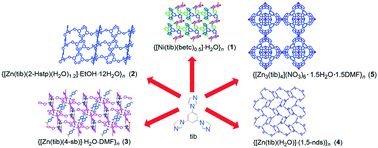Auxiliary ligand-modulated trisimidazole-based coordination polymers: syntheses, structures and photoluminescence properties†
Abstract
A set reaction of a rigid trisimidazole-based ligand with different auxiliary O-donor ligands gave rise to five trisimidazole-based coordination polymers, {[Ni(tib)(betc)0.5]·H2O}n (1, tib = 1,3,5-tris(1-imidazolyl)benzene, betc4− = 1,2,4,5-benzenetetracarboxylate), {[Zn5(tib)5(2-Hstp)5(H2O)6]·EtOH·12H2O}n (2, 2-Hstp2− = 2-hydrosulfoterephthalate), {[Zn(tib)(4-sb)]·H2O·DMF}n (3, 4-sb2− = 4-sulfobenzoate), {[Zn(tib)(H2O)]·(1,5-nds)}n (4, 1,5-nds2− = 1,5-naphthalenedisulfonate) and {[Zn3(tib)4](NO3)6·1.5H2O·1.5DMF}n (5). Their structures have been determined by single-crystal X-ray diffraction analyses and further characterized by Fourier-transform infrared spectroscopy (FTIR), elemental analyses and powder X-ray diffraction (PXRD) analyses. Compound 1 features a 3-nodal (3,4,5)-connected 3D framework with a point symbol of (3·92)3(4·6·8)2(6·93·126) topology. Compound 2 is a 2D wave-like layered solid in which the sheets are further assembled via hydrogen bonds and π–π interactions into a 3D supramolecular framework. Compound 3 presents a 2D protuberant network with a 4·82 topology, which extends into a 3D framework via π–π stacking and hydrogen bonding interactions. Compound 4 consists of 2D undulated cationic layers with a 4·82 topology that is charge balanced by the included 1,5-nds2− anions. Hydrogen bonds among the water molecules and the 1,5-nds2− anions further link these layers into a 3D supramolecular framework with 1D channels. Compound 5 shows a 2-nodal (3,4)-connected 3D framework possessing 1D channels occupied by the guest DMF and H2O molecules. The cationic network is charge balanced by the nitrate ions and displays a novel point symbol of {32·4}6{36·46·53} topology. The structural discrepancies of compounds 1–5 indicate that the presence of the different organic anions plays important roles in the formation of the final structures of the coordination polymers. In addition, their thermal stabilities and photoluminescence properties in the solid state were also investigated.

- This article is part of the themed collection: Coordination Networks


 Please wait while we load your content...
Please wait while we load your content...